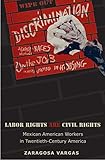Labor Rights Are Civil Rights : Mexican American Workers in Twentieth-Century America / Zaragosa Vargas.
Material type: TextSeries: Politics and Society in Modern America ; 92Publisher: Princeton, NJ : Princeton University Press, [2013]Copyright date: ©2004Edition: Course BookDescription: 1 online resource (400 p.) : 20 halftonesContent type:
TextSeries: Politics and Society in Modern America ; 92Publisher: Princeton, NJ : Princeton University Press, [2013]Copyright date: ©2004Edition: Course BookDescription: 1 online resource (400 p.) : 20 halftonesContent type: - 9780691134024
- 9781400849284
- 331.62720730904 22
- HD8081.M6 V36 2008eb
- online - DeGruyter
- Issued also in print.
| Item type | Current library | Call number | URL | Status | Notes | Barcode | |
|---|---|---|---|---|---|---|---|
 eBook
eBook
|
Biblioteca "Angelicum" Pont. Univ. S.Tommaso d'Aquino Nuvola online | online - DeGruyter (Browse shelf(Opens below)) | Online access | Not for loan (Accesso limitato) | Accesso per gli utenti autorizzati / Access for authorized users | (dgr)9781400849284 |
Frontmatter -- Contents -- Acknowledgments -- Abbreviations -- Introduction -- CHAPTER ONE. We Are the Salt of the Earth: Conditions among Mexican Workers in the Early Great Depression Years -- CHAPTER TWO. Gaining Strength through the Union: Mexican Labor Upheavals in the Era of the NRA -- CHAPTER THREE. "Do You See the Light?": Mexican American Workers and CIO Organizing -- CHAPTER FOUR. Advocates of Racial Democracy: Mexican American Workers Fight for Labor and Civil Rights in the Early World War II Years -- CHAPTER FIVE. The Lie of "America's Greatest Generation": Mexican Americans Fight against Prejudice, Intolerance, and Hatred during World War II -- CHAPTER SIX. Labor Rights Are Civil Rights: The Emergence of the Mexican American Civil Rights Struggle -- Conclusion -- Notes -- Index -- Backmatter
restricted access online access with authorization star
http://purl.org/coar/access_right/c_16ec
In 1937, Mexican workers were among the strikers and supporters beaten, arrested, and murdered by Chicago policemen in the now infamous Republic Steel Mill Strike. Using this event as a springboard, Zaragosa Vargas embarks on the first full-scale history of the Mexican-American labor movement in twentieth-century America. Absorbing and meticulously researched, Labor Rights Are Civil Rightspaints a multifaceted portrait of the complexities and contours of the Mexican American struggle for equality from the 1930s to the postwar era. Drawing on extensive archival research, Vargas focuses on the large Mexican American communities in Texas, Colorado, and California. As he explains, the Great Depression heightened the struggles of Spanish speaking blue-collar workers, and employers began to define citizenship to exclude Mexicans from political rights and erect barriers to resistance. Mexican Americans faced hostility and repatriation. The mounting strife resulted in strikes by Mexican fruit and vegetable farmers. This collective action, combined with involvement in the Communist party, led Mexican workers to unionize. Vargas carefully illustrates how union mobilization in agriculture, tobacco, garment, and other industries became an important vehicle for achieving Mexican American labor and civil rights. He details how interracial unionism proved successful in cross-border alliances, in fighting discriminatory hiring practices, in building local unions, in mobilizing against fascism and in fighting brutal racism. No longer willing to accept their inferior status, a rising Mexican American grassroots movement would utilize direct action to achieve equality.
Issued also in print.
Mode of access: Internet via World Wide Web.
In English.
Description based on online resource; title from PDF title page (publisher's Web site, viewed 29. Jul 2021)


